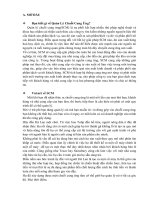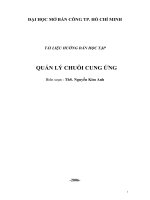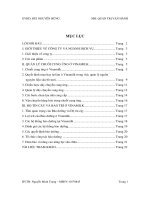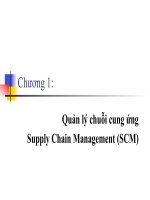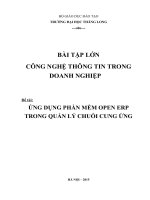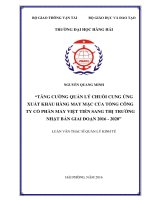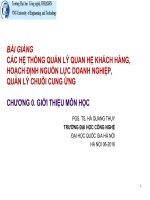Quản lý chuỗi cung ứng (3rd Edition) ppt
Bạn đang xem bản rút gọn của tài liệu. Xem và tải ngay bản đầy đủ của tài liệu tại đây (99.05 KB, 22 trang )
© 2007 Pearson Education
14-1
Chapter 13
Transportation in the Supply Chain
Supply Chain Management
(3rd Edition)
© 2007 Pearson Education
14-2
Outline
◆
The role of transportation in the supply chain
◆
Factors affecting transportation decisions
◆
Modes of transportation and their performance
characteristics
◆
Design options for a transportation network
◆
Trade-offs in transportation design
◆
Tailored transportation
◆
Routing and scheduling in transportation
◆
Making transportation decisions in practice
© 2007 Pearson Education
14-3
Factors Affecting
Transportation Decisions
◆
Carrier (party that moves or transports the product)
–
Vehicle-related cost
–
Fixed operating cost
–
Trip-related cost
◆
Shipper (party that requires the movement of the
product between two points in the supply chain)
–
Transportation cost
–
Inventory cost
–
Facility cost
© 2007 Pearson Education
14-4
Transportation Modes
◆
Trucks
–
TL
–
LTL
◆
Rail
◆
Air
◆
Package Carriers
◆
Water
◆
Pipeline
© 2007 Pearson Education
14-5
Truckload (TL)
◆
Average revenue per ton mile (1996) = 9.13 cents
◆
Average haul = 274 miles
◆
Average Capacity = 42,000 - 50,000 lb.
◆
Low fixed and variable costs
◆
Major Issues
–
Utilization
–
Consistent service
–
Backhauls
© 2007 Pearson Education
14-6
Less Than Truckload (LTL)
◆
Average revenue per ton-mile (1996) = 25.08 cents
◆
Average haul = 646 miles
◆
Higher fixed costs (terminals) and low variable costs
◆
Major issues:
–
Location of consolidation facilities
–
Utilization
–
Vehicle routing
–
Customer service
© 2007 Pearson Education
14-7
Rail
◆
Average revenue / ton-mile (1996) = 2.5 cents
◆
Average haul = 720 miles
◆
Average load = 80 tons
◆
Key issues:
–
Scheduling to minimize delays / improve service
–
Off-track delays (at pickup and delivery end)
–
Yard operations
–
Variability of delivery times
© 2007 Pearson Education
14-8
Air
◆
Key issues:
–
Location/number of hubs
–
Location of fleet bases/crew bases
–
Schedule optimization
–
Fleet assignment
–
Crew scheduling
–
Yield management
© 2007 Pearson Education
14-9
Package Carriers
◆
Companies like FedEx, UPS, USPS, that carry small packages
ranging from letters to shipments of about 150 pounds
◆
Expensive
◆
Rapid and reliable delivery
◆
Small and time-sensitive shipments
◆
Preferred mode for e-businesses (e.g., Amazon, Dell,
McMaster-Carr)
◆
Consolidation of shipments (especially important for package
carriers that use air as a primary method of transport)
© 2007 Pearson Education
14-10
Water
◆
Limited to certain geographic areas
◆
Ocean, inland waterway system, coastal waters
◆
Very large loads at very low cost
◆
Slowest
◆
Dominant in global trade (autos, grain, apparel, etc.)
© 2007 Pearson Education
14-11
Pipeline
◆
High fixed cost
◆
Primarily for crude petroleum, refined petroleum
products, natural gas
◆
Best for large and predictable demand
◆
Would be used for getting crude oil to a port or
refinery, but not for getting refined gasoline to a
gasoline station (why?)
© 2007 Pearson Education
14-12
Intermodal
◆
Use of more than one mode of transportation to move a shipment to
its destination
◆
Most common example: rail/truck
◆
Also water/rail/truck or water/truck
◆
Grown considerably with increased use of containers
◆
Increased global trade has also increased use of intermodal
transportation
◆
More convenient for shippers (one entity provides the complete
service)
◆
Key issue involves the exchange of information to facilitate
transfer between different transport modes
© 2007 Pearson Education
14-13
Design Options for a
Transportation Network
◆
What are the transportation options? Which one to
select? On what basis?
◆
Direct shipping network
◆
Direct shipping with milk runs
◆
All shipments via central DC
◆
Shipping via DC using milk runs
◆
Tailored network
© 2007 Pearson Education
14-14
Trade-offs in Transportation Design
◆
Transportation and inventory cost trade-off
–
Choice of transportation mode
–
Inventory aggregation
◆
Transportation cost and responsiveness trade-off
© 2007 Pearson Education
14-15
Choice of Transportation Mode
◆
A manager must account for inventory costs when
selecting a mode of transportation
◆
A mode with higher transportation costs can be
justified if it results in significantly lower inventories
© 2007 Pearson Education
14-16
Inventory Aggregation: Inventory
vs. Transportation Cost
◆
As a result of physical aggregation
–
Inventory costs decrease
–
Inbound transportation cost decreases
–
Outbound transportation cost increases
◆
Inventory aggregation decreases supply chain costs if
the product has a high value to weight ratio, high
demand uncertainty, or customer orders are large
◆
Inventory aggregation may increase supply chain
costs if the product has a low value to weight ratio,
low demand uncertainty, or customer orders are small
© 2007 Pearson Education
14-17
Trade-offs Between Transportation
Cost and Customer Responsiveness
◆
Temporal aggregation is the process of combining
orders across time
◆
Temporal aggregation reduces transportation cost
because it results in larger shipments and reduces
variation in shipment sizes
◆
However, temporal aggregation reduces customer
responsiveness
© 2007 Pearson Education
14-18
Tailored Transportation
◆
The use of different transportation networks and
modes based on customer and product characteristics
◆
Factors affecting tailoring:
–
Customer distance and density
–
Customer size
–
Product demand and value
© 2007 Pearson Education
14-19
Role of IT in Transportation
◆
The complexity of transportation decisions demands to
use of IT systems
◆
IT software can assist in:
–
Identification of optimal routes by minimizing costs subject
to delivery constraints
–
Optimal fleet utilization
–
GPS applications
© 2007 Pearson Education
14-20
Risk Management in Transportation
◆
Three main risks to be considered in transportation are:
–
Risk that the shipment is delayed
–
Risk of disruptions
–
Risk of hazardous material
◆
Risk mitigation strategies:
–
Decrease the probability of disruptions
–
Alternative routings
–
In case of hazardous materials the use of modified
containers, low-risk transportation models, modification of
physical and chemical properties can prove to be effective
© 2007 Pearson Education
14-21
Making Transportation
Decisions in Practice
◆
Align transportation strategy with competitive
strategy
◆
Consider both in-house and outsourced transportation
◆
Design a transportation network that can handle
e-commerce
◆
Use technology to improve transportation
performance
◆
Design flexibility into the transportation network
© 2007 Pearson Education
14-22
Summary of Learning Objectives
◆
What is the role of transportation in a supply chain?
◆
What are the strengths and weaknesses of different
transport modes?
◆
What are the different network design options and
what are their strengths and weaknesses?
◆
What are the trade-offs in transportation network
design?
